Have you ever felt that something was “off” about your audio setup, but couldn’t quite identify the problem? The music doesn’t sound as immersive as it should, dialogue in movies seems to drift, or game audio cues feel misleading. The culprit might be poor channel balance between your left and right speakers – an issue that’s remarkably common yet frequently overlooked.
In this comprehensive guide, we’ll explore why proper channel balance is absolutely essential for any listening experience, how to identify imbalance problems, and how simple left-right speaker tests can dramatically improve your audio enjoyment. Whether you’re a casual listener or dedicated audiophile, understanding channel balance will transform how you hear your favorite content.
What is Channel Balance?
Channel balance refers to the equal distribution of audio signals between your speakers. In a properly balanced system, sounds meant to come from the center (like a vocalist in a music recording) will appear to originate from a point directly between your speakers, while sounds panned to either side will seem to come from their appropriate locations.
This isn’t just about volume matching, though that’s a crucial component. True channel balance encompasses:
- Equal volume levels between left and right channels
- Consistent frequency response across both speakers
- Proper time alignment ensuring sounds arrive at your ears correctly
- Similar dispersion characteristics from both speakers
When these elements work in harmony, they create what audio enthusiasts call a “soundstage” – a three-dimensional audio space where instruments and sounds appear to occupy specific positions. Think of it as the audio equivalent of a 3D movie, where proper channel balance provides the “depth” that makes the experience convincing.
Signs of Poor Channel Balance
How do you know if your system suffers from channel imbalance? Here are the telltale signs:
Shifted Sound Image
The most obvious symptom is when audio appears to come predominantly from one side. This “shifted” sound image means your center-panned content (like vocals or dialogue) doesn’t appear to come from the center, but instead leans toward either the left or right speaker.
Inconsistent Sound Distribution
Walking across your listening area should maintain relatively consistent sound quality. With poor channel balance, the sound might change dramatically as you move, with certain positions sounding significantly better than others.
Reduced Soundstage Width
Well-recorded music should create a soundstage that extends beyond the physical location of your speakers. With channel imbalance, this soundstage collapses, making everything sound like it’s coming directly from the speaker locations rather than creating a wide, immersive experience.
Listening Fatigue
Perhaps most telling is the sensation of listening fatigue – when your audio system causes unexplained tiredness or discomfort during extended listening sessions. Your brain works overtime to compensate for the unnatural sound presentation, leading to fatigue even at moderate volumes.
Why Channel Balance is Essential for Different Listening Experiences
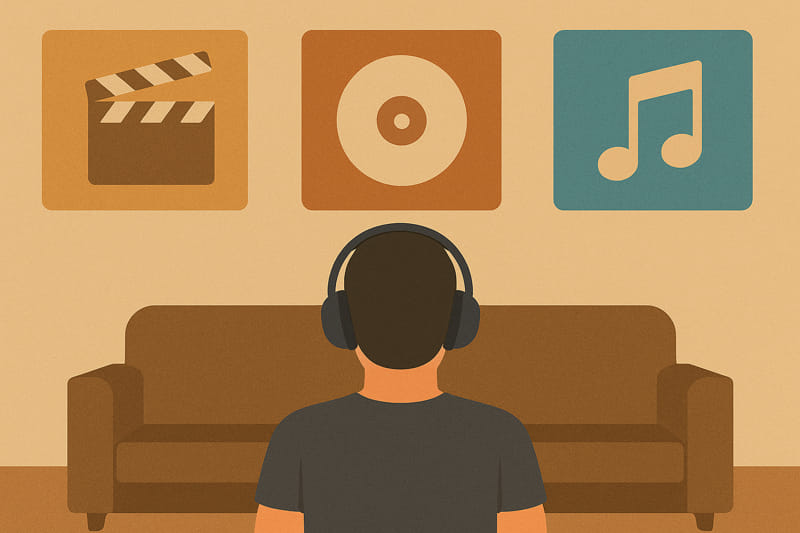
The impact of channel balance varies depending on how you use your audio system. Let’s examine why it matters across different media:
Music Listening
Music production is an art form that relies heavily on stereo imaging. From The Beatles’ experimental stereo mixes to modern immersive recordings, artists and producers carefully place instruments and vocals within the stereo field to create specific emotional effects.
Take Pink Floyd’s “Dark Side of the Moon” as an example – the album’s famous clock sounds in “Time” should circle around you in a properly balanced system. With poor channel balance, this carefully crafted effect collapses, robbing you of the experience the artists intended.
For classical music enthusiasts, proper channel balance recreates the concert hall experience, with string sections, brass, woodwinds and percussion all appearing in their correct spatial positions. Without it, the orchestra sounds flattened and unnatural.
Gaming
In competitive gaming, audio cues provide critical information that can mean the difference between victory and defeat. Footsteps, gunfire, and environmental sounds are purposefully positioned to help players identify threats and opportunities.
With poor channel balance, an enemy’s footsteps might sound like they’re coming from the wrong direction, leading to confused responses and preventable losses. For serious gamers, proper channel balance isn’t just about immersion – it’s a competitive necessity.
Movies and TV
Film sound designers craft intricate audio landscapes that extend the visual experience. Proper channel balance ensures that dialogue remains anchored to the center while effects move naturally across the soundstage.
Consider a car chase scene: the vehicle should track smoothly from left to right as it crosses the screen. With channel imbalance, this movement becomes jarring and unnatural, breaking the immersive experience the filmmaker intended.
Even for casual TV watching, poor channel balance can make dialogue harder to understand, forcing you to raise the volume and potentially creating new problems with overly loud effects or music.
Common Causes of Channel Imbalance
Several factors can contribute to channel imbalance in your audio system:
Physical Speaker Placement Issues
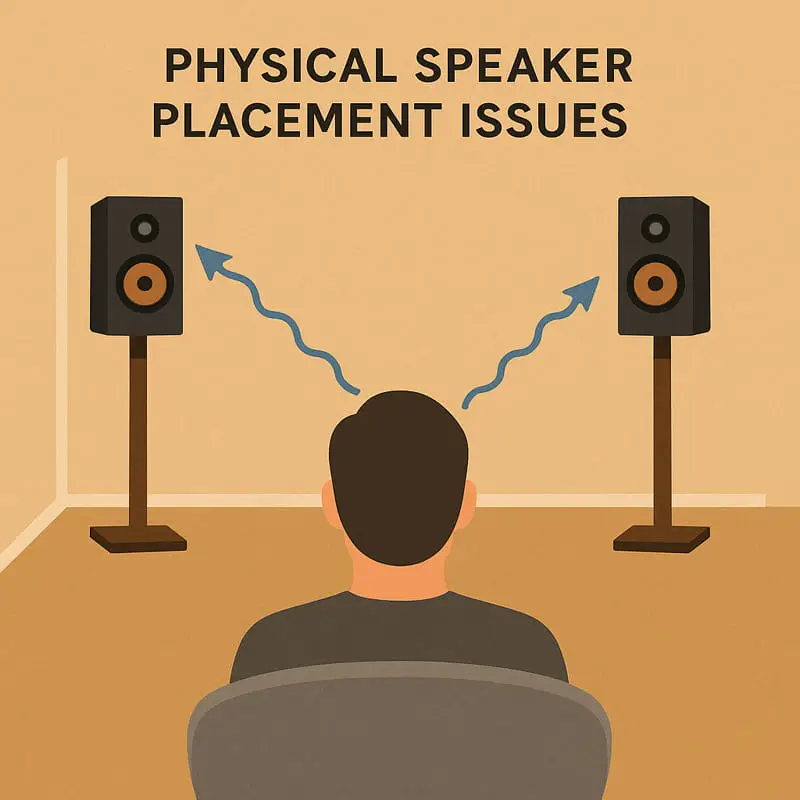
Asymmetrical speaker positioning is perhaps the most common cause of channel imbalance. When speakers aren’t placed at equal distances from your listening position or aren’t positioned at the same height, sound waves arrive at your ears at different times and intensities.
For optimal balance, ensure that:
- Both speakers are the same distance from your listening position
- Both are at the same height
- Both are angled similarly toward your listening position
- Neither speaker is blocked by furniture or objects
Audio Equipment Problems
Issues with amplifiers, digital-to-analog converters (DACs), and other components can cause channel imbalance. Common hardware problems include:
- Aging potentiometers (volume controls) that develop resistance imbalances
- Failing capacitors in crossover networks
- Damaged driver units in speakers
- Worn connections between components
Software Settings
In digital systems, software settings often create channel imbalances:
- Operating system balance controls accidentally adjusted
- Media player equalizer settings applied to one channel
- Spatial audio enhancements that modify channel balance
- Incorrect driver settings for audio interfaces
Room Acoustics
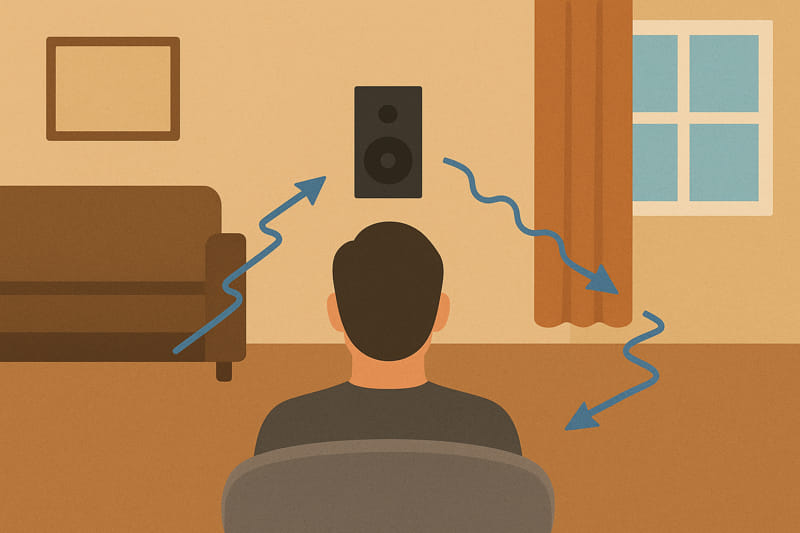
Even with perfect equipment and settings, your room itself can create channel imbalance:
- Asymmetrical furniture placement that affects sound reflection
- Different wall treatments on left versus right sides
- Windows on only one side creating uneven reflections
- Room modes (standing waves) affecting certain frequencies
Age-Related Speaker Degradation
Speakers naturally degrade over time, and rarely do both speakers age identically:
- Driver surrounds might deteriorate at different rates
- Voice coils can develop different electrical characteristics
- Crossover components may drift in value as they age
- Cabinet seals might fail, affecting bass response differently between speakers
How to Perform a Proper Left-Right Speaker Test
A systematic left-right speaker test is the best way to identify and resolve channel balance issues. Here’s how to conduct one properly:
Step 1: Prepare Your Environment
- Minimize background noise
- Position yourself at your primary listening position
- Ensure both speakers are unobstructed
- Turn off any sound processing features (like virtual surround or “enhanced” modes)
Step 2: Use a Dedicated Testing Tool
While you could use music to test for balance, purpose-built test signals provide more reliable results. SpeakerTest.app offers a comprehensive left-right speaker test that walks you through the entire process.
Our free online tool provides:
- Calibrated test tones for left and right channels
- Voice announcements identifying each channel
- Frequency sweeps to check full-range performance
- Pink noise for overall balance assessment
- Visual guidance to interpret what you’re hearing
Step 3: Listen for These Specific Elements
During your left-right speaker test, pay attention to:
Channel Identification When the test announces “left channel” or “right channel,” verify that the sound is coming from the correct speaker. If the sound seems to be coming from the wrong location, you may have your speakers wired incorrectly.
Equal Volume Both channels should sound equally loud from your listening position. If one consistently sounds louder, you likely have a balance issue.
Frequency Response As frequency sweeps play through each channel, both speakers should reproduce the full range of tones similarly. Pay attention to whether bass, midrange, and treble sound equally present from both speakers.
Coherent Center Image When identical signals play through both speakers, the sound should appear to come from a phantom center point between the speakers. If this center image drifts to one side, you have a channel imbalance.
Step 4: Interpret Your Results
Based on your left-right speaker test, you can identify specific issues:
- If only certain frequencies are imbalanced, you may have a speaker driver or crossover issue
- If all frequencies lean to one side, check your balance settings and speaker placement
- If the imbalance changes as you move around, room acoustics likely play a role
- If one speaker sounds distorted compared to the other, you might have a damaged driver
Fixing Channel Balance Issues
Once you’ve identified channel balance problems, here’s how to address them:
Simple Fixes
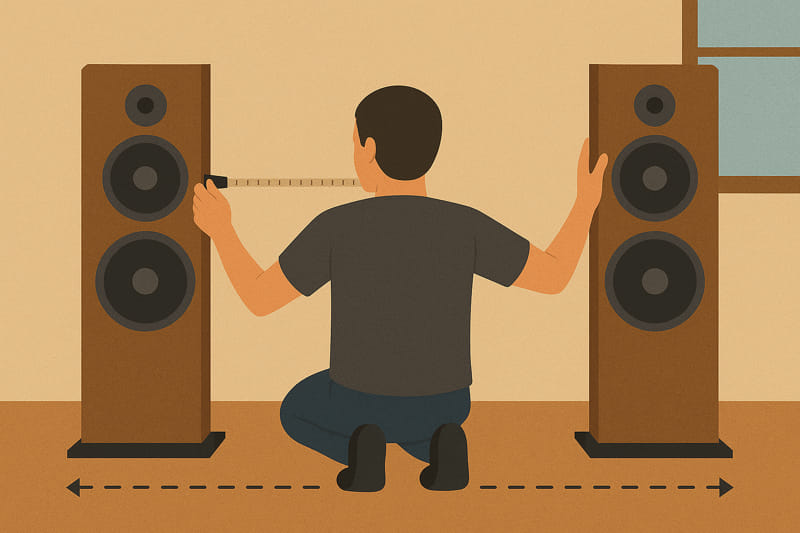
Adjust Physical Speaker Placement Often, simply repositioning your speakers solves major balance issues:
- Measure the distance from each speaker to your listening position and equalize them
- Ensure both speakers are angled at the same degree toward your listening position
- Keep both speakers at the same height
- Maintain equal distance from side walls when possible
Check Software Balance Settings Verify that your sound settings aren’t causing the imbalance:
- Check your operating system’s sound control panel for balance settings
- Ensure media player equalizers are centered
- Disable any “enhanced audio” features that might affect balance
- Reset any room correction systems and recalibrate them if necessary
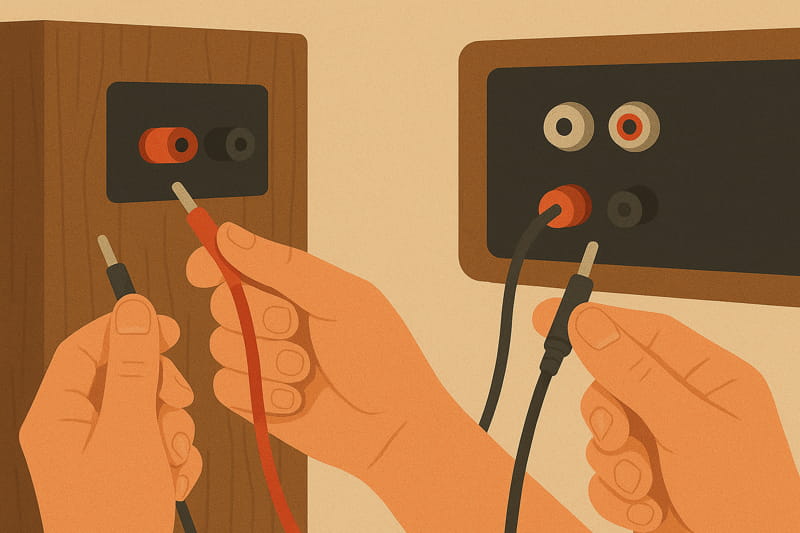
Verify Cable Connections Poor connections often cause channel imbalance:
- Check that all audio cables are fully inserted
- Look for damage or corrosion on connectors
- Try swapping cables to see if the problem moves with the cable
- Ensure speaker wire polarity is consistent (red to red, black to black)
Intermediate Solutions
Room Acoustic Treatments Strategic acoustic treatments can dramatically improve channel balance:
- Add absorption panels at first reflection points on both side walls
- Use bass traps in corners to manage low-frequency response
- Add diffusion on the back wall to control reflections
- Use a rug or carpet between you and the speakers if on a hard floor
Speaker Isolation and Mounting How your speakers couple with surfaces affects their sound:
- Use isolation pads under speakers to prevent surface vibrations
- Ensure speaker stands are stable and identical for both channels
- Consider wall-mounting bookshelf speakers at equal heights
- Use spikes or feet consistently on floor-standing speakers
Amplifier and Receiver Adjustments Modern receivers often include channel level adjustments:
- Use the receiver’s built-in test tones to balance channel levels
- Check if your amplifier has individual channel gain controls
- Verify any tone controls are set identically for both channels
- Consider using the receiver’s auto-calibration system if available
Advanced Remedies
Digital Room Correction Systems For persistent issues, digital room correction can help:
- Systems like Dirac Live, Audyssey, or ARC Genesis can measure and correct for room-based imbalances
- These systems analyze your specific room and speaker combination
- They create custom filters to compensate for measured differences
- They can address frequency-dependent channel imbalances that simple level adjustments can’t fix
Professional Calibration Sometimes, bringing in a professional is the best solution:
- Audio calibration specialists have sophisticated measurement equipment
- They can identify issues that might be difficult to hear
- They understand the interaction between speakers and room acoustics
- They can provide customized solutions for complex problems
Equipment Upgrades In some cases, upgrading components solves persistent balance issues:
- Replace aging speakers that have developed driver imbalances
- Upgrade to an amplifier with better channel matching
- Consider digital sources with superior DACs for better channel separation
- Invest in higher-quality cables for consistent signal transfer
The Science Behind Stereo Imaging
To fully appreciate why channel balance matters, it helps to understand the psychoacoustic principles behind stereo imaging.
A Brief History of Stereo Sound
Stereo reproduction was pioneered in the 1930s but didn’t become widespread until the late 1950s. The breakthrough came from understanding how humans perceive directional sound cues. By recording and reproducing sound through two separate channels, audio engineers could create the illusion of a spatial soundfield.
How Our Brains Process Directional Audio
Our ears and brain use several mechanisms to locate sounds:
- Interaural Time Difference (ITD): Sounds reach our ears at slightly different times depending on their origin
- Interaural Level Difference (ILD): Sounds appear louder in the ear closer to their source
- Spectral cues: Our outer ears filter sounds differently based on their direction
- Precedence effect: We localize sounds based on the first arrival, ignoring later reflections
Proper channel balance ensures these cues are accurately reproduced, allowing our brains to construct a convincing spatial image.
The Phantom Center Phenomenon
Perhaps the most magical aspect of stereo is the “phantom center” – when identical signals from both speakers create the illusion of a sound source directly between them. This phenomenon depends entirely on precise channel balance. Even small imbalances can shift this phantom center, making vocals or dialogue appear to come from one side rather than the middle.
Beyond Basic Left-Right Balance: Advanced Concepts
For those looking to perfect their audio systems, several advanced concepts affect channel balance:
Frequency-Dependent Channel Balance
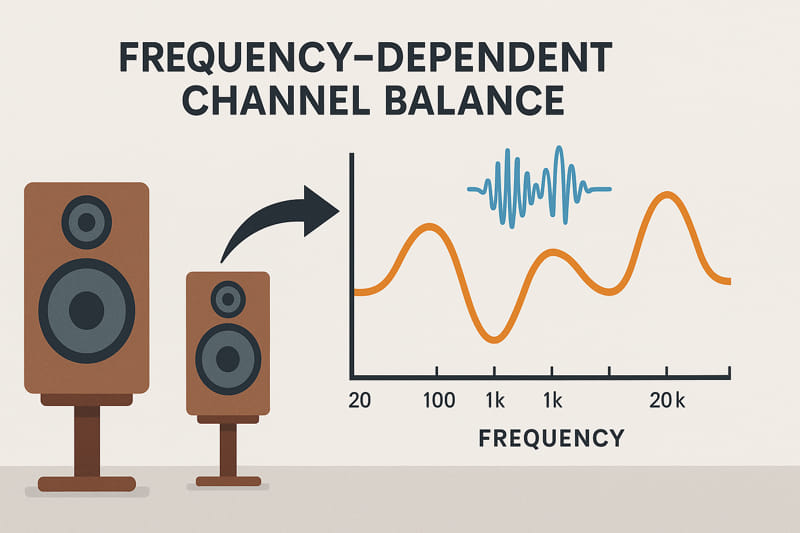
Channel balance isn’t necessarily consistent across all frequencies. A system might be perfectly balanced in the midrange but have imbalances in the bass or treble regions. This typically stems from:
- Different room modes affecting low frequencies differently at each speaker position
- High-frequency driver performance variations between speakers
- Crossover component tolerances causing different frequency responses
SpeakerTest.app’s frequency sweep test helps identify these issues by playing tones across the audible spectrum through each speaker individually.
Phase Coherence Between Channels
Phase refers to the timing relationship between audio signals. Proper stereo imaging requires not just amplitude balance but also phase coherence between channels. Phase issues can arise from:
- Speaker placement that creates unequal distances to the listening position
- Driver alignment differences between speakers
- Electrical problems causing phase shifts in one channel
- Digital processing delays affecting one channel differently
Time Alignment Considerations
Related to phase, time alignment ensures that all frequencies from both speakers arrive at your ears at the correct times. Factors affecting time alignment include:
- Driver mounting depths within speaker cabinets
- Digital processing delays
- Different speaker designs in a mismatched pair
- Uneven distances from listening position
Perfect time alignment contributes to sharper imaging and more coherent sound reproduction.
Tools for Testing and Maintaining Channel Balance
Maintaining optimal channel balance requires periodic testing. Here are the best tools for the job:
SpeakerTest.app’s Comprehensive Testing Features
Our free online speaker test tool provides everything you need to assess and maintain channel balance:
- Left-Right Balance Test: Verify basic channel identification and balance
- Frequency Sweep Test: Check frequency-dependent balance issues
- Pink Noise Test: Assess overall tonal balance between channels
- Custom Audio Upload: Test with your own familiar content
- Channel Identification: Confirm proper speaker wiring and setup
Unlike expensive equipment, SpeakerTest.app runs in any web browser, making professional-quality testing accessible to everyone.
Other Useful Tools for Audio Enthusiasts
For those wanting to go deeper, consider:
- SPL meter apps: Measure actual sound pressure levels at your listening position
- Room measurement software: Analyze frequency response differences between channels
- Tone generators: Create specific test frequencies to pinpoint problem areas
- Binaural recordings: Test spatial audio reproduction with known reference material
Professional Equipment vs. Free Online Solutions
While professional audio measurement equipment offers greater precision, SpeakerTest.app provides 95% of the benefits for casual listeners and enthusiasts. Professional tools might be overkill unless you’re:
- Setting up a recording studio
- Calibrating a high-end home theater
- Troubleshooting persistent, subtle issues
- Performing scientific acoustic measurements
For most listeners, our free online tests will identify the major issues affecting your listening experience.
Conclusion: Don’t Underestimate the Power of Proper Channel Balance
In our quest for better sound, we often focus on buying new equipment while neglecting the fundamentals of proper setup. Channel balance might not be as exciting as unboxing new speakers, but it has a more profound impact on your listening experience than many equipment upgrades.
When your system is properly balanced:
- Music regains its spatial qualities and emotional impact
- Movie dialogue becomes clearer and more natural
- Games provide more accurate positional audio cues
- Listening fatigue diminishes, even during extended sessions
Best of all, achieving proper channel balance often costs nothing but a little time and attention. Regular left-right speaker tests should be part of your audio maintenance routine, especially after moving speakers, changing equipment, or rearranging your listening room.
Ready to experience what you’ve been missing? Take five minutes to run our free left-right speaker test at SpeakerTest.app and discover how much better your audio system can sound with proper channel balance.
Frequently Asked Questions
How often should I test my speakers’ channel balance?
We recommend testing channel balance in these situations:
- After initial setup of new equipment
- When rearranging your listening room
- If you notice something sounds “off” about your audio
- At least once every six months as preventative maintenance
- After any software updates that might affect audio settings
Can channel imbalance damage my audio equipment?
Channel imbalance itself won’t damage your equipment, but the causes of imbalance (like failing drivers or amplifier issues) might indicate problems that could lead to damage if left unaddressed.
Does speaker age affect channel balance?
Yes, speakers age unevenly. Component tolerances drift over time, and mechanical parts like speaker surrounds degrade at different rates. This is especially true if one speaker has been exposed to more sunlight, humidity, or temperature extremes than the other.
How does room size impact stereo imaging?
Larger rooms typically create more reflection points and can make precise imaging more challenging. In smaller rooms, standing waves and boundary reinforcement can cause more pronounced frequency-dependent balance issues. Each room size presents unique challenges that can be identified through proper testing.
Can headphones have channel balance issues too?
Absolutely. Headphones can suffer from manufacturing variations, driver aging, and cable issues that create channel imbalance. Many of the same principles apply, though headphones eliminate room acoustics from the equation. SpeakerTest.app works equally well for testing headphone channel balance.
What’s the easiest way to fix severe channel imbalance?
Start with the simplest potential causes:
- Check your device’s balance control settings
- Verify proper speaker placement and positioning
- Inspect and reconnect all cables
- Try different content to confirm the issue isn’t with a specific recording
If these steps don’t resolve the issue, use SpeakerTest.app’s diagnostic tools to isolate whether the problem is frequency-specific or affects the entire range, which will guide your next troubleshooting steps.

